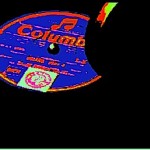No, this is not a composite shot, nor has it been Photoshopped: this is an undoctored snapshot of fish in a hotel lobby. Note how well they coordinate with the wallpaper.
So did I somehow manage to capture flying fish in an unguarded moment? Of course not: as the coral in the bottom right-hand corner might have tipped you off, I took this picture through a large fish tank that had been impeccably cleaned that morning.
The fish are, as one might expect, swimming, and through a more familiar medium than air. Yet while you and I both know that those fish are not actually paddling madly through the lobby, bumping into those hastily checking out, someone unfamiliar with the habits of fish or the ambient conditions of hotel lobbies might assume otherwise, based on what is visible here.
Bear our fishy friends in mind, please, as we wend our way through today’s exploration of all things query-related. This photo illustrates some basic facts of querying: since the writer is so familiar with her own manuscript, she sometimes forgets that the query-reader — the agent of her dreams, or more often, the Millicent employed to screen queries for the agent of her dreams — can judge a queried book’s content only by what actually makes it into the letter. All too often, a vague descriptive paragraph, one that talks about the book rather than telling its story, leaves poor Millie guessing.
Not buying that analogy? Okay, try this one on for size: the chances of landing an agent by addressing a query to just any agent — or, sacre bleu, to Dear Agent at just any agency — without first ascertaining that the intended recipient does in fact represent your type of book are about as high as strolling into a hotel lobby to snag the morning paper and being greeted by fish lazily meandering through the air. It could appear to be the way things work, but if you’ll look a little closer, those seemingly free-ranging fish are confined.
Not crazy about that analogy, either? Here’s an even more fundamental querying truth, a corollary of the first: regardless of what a writer intends to say in a query letter, Millicent must rely upon what it actually says. No matter how beautifully the manuscript in question may be written, if the query is awkward — as, let’s face it, hastily thrown-together missives tend to be — you really can’t blame her for leaping to the conclusion that the manuscript’s writing suffers from the same malady.
Okay, so maybe you are capable of blaming her, in the dark of night and the privacy of your studio. But it isn’t really her fault: a single-page query letter does not provide a heck of a lot of information upon which to make a determination about whether to request manuscript pages. If that information is conveyed poorly — or, even more common, if some of that information doesn’t make it into the query letter for the simple reason that the writer doesn’t know it should be there — the query is often self-rejecting.
What does that have to do with our friends the fish, you ask? No matter how pretty they may look soaring through the air in front of the lobby’s dubious artwork, the sight of them is inherently jarring. The onlooker expects fish to appear only within certain contexts. While a fish out of water will always catch the eye, the connoisseur of fins will be looking to the briny deep to find the best specimens.
Yes, that was rather a stretch, now that you mention it, but I wanted to use the photo. Just present your query as Millicent expects to see it, okay?
Since quite a few of the elements of a professionally-presented query are a bit counterintuitive, especially to those writing one for the first time, it’s important not to rush the process. Yes, it’s tedious, not nearly as much fun as writing the book itself. However, I’d much, much rather see my readers spend an extra week or two on drafting a really good query letter than to have any of you kicking yourselves a month from now, wishing you’d queried differently.
Especially if the difference between popping it in the mail on Monday morning and three Mondays from now means being able to have someone whose literary (and grammatical) opinion you trust read your query draft. Even if a writer’s been at it a while, it can be pretty hard to see the flaws in one’s own query letters — and for some reason I have never been able to fathom, even aspiring writers professional enough to be routinely soliciting feedback on their manuscripts often guard their queries jealously from any human eyes other than Millicent’s.
Whose peepers, as those of you who have been visiting this blog for a good long time are already aware, are not generally charitably-oriented. Is she really the first sentient being you want seeing your query?
All too often, the answer is yes, occasionally with disastrous consequences. The dangers of sending off a first draft should be self-evident — and if they are not, allow me to refer you to those earlier fish analogies. (Oh, you thought I had time to run these posts through multiple drafts?) It can take even a very gifted writer a few tries to get it right.
Not that over-tinkering doesn’t carry its own perils. Certain gaffes are as likely to turn up in queries penned by writers accustomed to the querying process as for those new to it.
How is that possible, you scream in horror? The nature of on-screen revision, for one thing. Since most experienced queriers will tweak their basic query letters to personalize them for each (don’t worry; I’ll be getting to that soon), there tends to be a lot of cutting, pasting, and general rewriting going on between mailings and/or strikings of the SEND button.
Here’s a pop quiz for those of you who were hanging around Author! Author! last spring: what extremely common outcome is likely to plague any piece of writing whose specifics have been constantly being revised over time without its author sitting down and re-reading the whole thing between revisions? Shout it out: it can turn into a Frankenstein manuscript, an unholy mish-mash of half-completed revisions.
The single most common type of Frankenstein query, as we saw last time, is the mismatched salutation and address. Nothing screams out I’m doing a mass mailing of queries, and you, sir, are palpably on the bottom of my wish list! like a letter that runs like the following. (As always, if you’re having trouble reading this example, try holding down the COMMAND key and pressing the + key to enlarge the image.)

See the problem? In the stress of sending out multiple queries — a smart strategy in its own right, by the way; with sometimes months-long turn-around times at some agencies and no-reply policies at others, waiting to hear back from Agent A before querying Agent B is a sure-fire strategy for wasting years of your life — Mssr. Flaubert copied the address of one agent onto a letter personalized for another.
What he intended to send (and probably didn’t ever notice he didn’t send) was this:
Clearly, our Gustave fell victim to query fatigue. Quite understandable, of course, but how do you think Ms. Marketer is likely to respond not only to being addressed by the wrong name and with the honorific for the wrong sex, but being congratulated for her speech at a conference she never attended?
That’s right, campers: “Next!”
So please, proofread every single query every single time . Yes, even e-queries. Many a Millicent has been left shaking her head regretfully over a dropped word or misspelling in an otherwise admirable query.
Better yet, have a first reader you trust go over it. This is an excellent contribution to your writing career for any significant others, family members, or friends whom you, in your great wisdom, have deemed too fond of you to be trusted to provide critical feedback on your manuscript. (Trust me, “But my mom loved it!” is not an argument that flies well in the publishing industry.) Often, these kind souls are only too glad to help, even with a task as inherently unglamorous as sitting down with your query in one hand and a checklist of the information it needs to contain in the other.
Another great employment for aid-eager friends: have ‘em read your query twice, then set it aside. Talk about something entirely different for five minutes — and then have ‘em tell you the premise of the book and why it will appeal to your target market. (It helps if you tell them up front that “Because Johnny wrote it!” is not an argument Millicent is likely to find convincing.) If you’re feeling really ambitious, hand the letter back to them and ask them to tell you why you’re targeting that particular agent with this particular manuscript.
Seem like a tall order? Actually, it isn’t: if you’ve described the book memorably, even a non-professional should be able to recall its premise. And if you’ve been direct in your first paragraph about why, out of all the proverbial fish in the sea, you’re angling for this one, a lay reader should be able to catch the reference.
A good first reader should also be able to tell you when it’s time to weed out puns like that last one. You wouldn’t want to receive that kind of painful feedback from a total stranger, would you?
Whatever you do, don’t fall into the oh-so-common trap of getting complacent about your basic query. Just because a letter has garnered chapter requests in the past does not mean that it couldn’t use a bit of punching up. Even if you are a querying veteran, at least cast your eye over this list of garden-variety query turn-offs.
That’s right, campers: it’s another of my famous faux pas check-lists.
Why should a writer who has been querying a while take the time to go through a do-not list? For most aspiring writers, it takes quite a bit of rejection to open their eyes to the possibility that their query letters themselves might be problematic, rather than the book being queried. Out comes the broken record:
Unfortunately, writers all too often automatically assume that it’s the idea of the book being rejected, rather than a style-hampered querying letter or a limp synopsis.
But how is this possible, without a level of mental telepathy on the screener’s part that would positively stun the Amazing Kreskin? Remember, all the information Millicent has about your book is on the query page.
Are the rejecting agents seeing past the initial letter to the manuscript itself, decreeing from afar that the writing is not worth reading — and thus that the writer should not be writing? Do they have some sort of direct cosmic link to the Muses that allows them to glance at the first three lines of a query and say, “Nope, this one was last in line when the talent was handed out. Sorry,” before they toss it into the rejection pile?
Of course not. Only editors have that kind of direct telephonic connection to the demi-gods.
Yet this particular fear leaps like a ravenous shark onto many fledgling writers, dragging them off the path to future efforts: it is the first cousin that dangerous, self-hating myth that afflicts too many writers, leading to despair, the notion that if one is really talented, the first draft, the first query, and the first book will automatically traject one to stardom.
It never — well, almost never — turns out like that. Out comes the broken record again:
Being a professional writer is work, and what gets the vast majority of queries rejected is a lack of adherence to professional standards. Which can, my friends, be learned.
As, indeed, we’ve already seen over the course of Queryfest. But what if you already have a query letter that meets all the technical criteria, and it’s still not garnering the responses you want?
Pull up your chairs close, boys and girls: it’s time for the master class on querying. Today, we’re going to concentrate on the delicate art of query diagnosis.
Why? I feel another broken record coming on:
The querying market is even tighter than it was the last time I visited this issue — and that’s really saying something. It’s as competitive now as it has ever been in my lifetime.
Seriously, there are a heck of a lot of fishies clamoring for just a couple of spots in Millicent’s boss’ aquarium. But before you begin to feel for your submission’s pulse, please (wait for it):
Re-read everything in your query packet IN HARD COPY and OUT LOUD: your query letter, synopsis, author bio, and ANY pages the agency’s website or agency guide listing has asked queriers to include in a querying packet.
Better still, read them over AND have someone you trust read it over as well, checking for logical holes and grammatical problems. For any attached pages, the best choice for this is another writer, ideally one who has successfully traversed the perils of the agent-finding ravine.
My, we’re covering a lot of different types of physical environment today, are we not? Let’s slap another broken record on the turntable:
As much as you may love your mother, your spouse, and your best friend, they are, generally speaking not the best judges of your writing.
Look to these fine folks for support, encouragement, and the occasional spot-check for salutation-matching, not for technical feedback on your writing. Find someone whose LITERARY opinion you trust — such as, say, a great writer you met at a conference, or the person in your writing group who keeps being asked to send sample chapters — and blandish her into giving your query packet materials a solid reading.
Lest you think I am casting unwarranted aspersions upon your mother, your spouse, or your best friend, let me add that my own fabulous mother spent her twenties editing the work of some major science fiction writers; fifty years later, she is one of the best line editors I have ever seen, in my professional opinion, but as she is my mother, I would never dream of using her as my only, or indeed even my primary feedback source. Naturally, that doesn’t stop her from line-editing while she reads my work, as I do for hers — years of professional editing causes a particular type of myopia that prevents one from ever reading again without brandishing a vicious pen that attacks margins with the intensity of a charging rhinoceros — but I respect my work enough to want first reader feedback from someone who was not there when I took my first toddling steps.
As excellent as this advice is, I sense that some of you are already merrily making plans to disregard it. If you are planning to be the only pre-Millicent peruser of your query packet, then I implore you…
Make sure that you read all of the constituent parts of your submissions in hard copy, not just on a computer screen. Proofreading is far easier — and more likely to be accurate — in hard copy.
I’m quite serious about treating this a final flight-check: don’t leave rooting out the proofreading and logic problems until the last minute. As Gustave knows to his sorrow, it’s just too easy to skip them when you’re in a hurry.
Once you have cleared out any grammatical or spelling problems and made sure your submission pieces say what you thought they were saying (you’d be surprised how many don’t), sit down with yourself and/or that trusted first reader and ask yourself the following questions.
(1) Is my query letter longer than a single page in standard correspondence format?
I know it’s hard to cram everything you want to say to promote your work into a single page, but it’s just not worth it to go longer: it’s a standard instant-rejection trigger. Yes, even if you are e-querying: I covered this earlier in this series, speaking of broken records, but even e-mailed queries longer than a page are seldom read in their entirety.
And please, for your own sake, don’t take the common escape route of shrinking the margins or the typeface; trust me, any screener, agent, editor, or contest judge with even a few weeks’ worth of experience can tell. (For a quick, visual-aid-assisted run-down on why their being able to tell that is bad news for the querier who does it, please see my last post.)
Remember, if you are sending a paper query or any pages at all (even if the agency’s guidelines ask you to imbed them in an e-mail),
You must indent your paragraphs in a mailed query letter — or, indeed, in any writing sample of any length intended for agent-dwelling eyes. Business format is not acceptable in this context.
For those of you unclear on the difference between correspondence format and business format (or, to put it another way, those who are coming upon this checklist in my archives, rather than reading it as today’s post), please see my earlier post on the subject.
(2) If my query letter just refuses to be shorter than a page, am I trying to achieve too much in it? Specifically, is my query trying to do more than get the agent to ask to see the manuscript?
Is it perhaps trying to convince the agent (or her Millicent) that this is a terrific book by assertion, rather than presenting the premise compellingly? It maybe attempting to summarize the entire plot, rather than the premise? Is it reviewing the book, rather than describing it? Is it begging for attention, rather than presenting the book professionally? Is it trying to suit the tastes of every agent to whom you might conceivably send it, rather than the one to whom it is currently addressed?
Query letters over-reach in these ways all the time. Like pitches, queries often turn into litanies of summary, rather than convincing, professional presentations of a book’s category, premise, and selling points. As I have advised before,
Don’t try to cram a half an hour’s worth of conversation about your book into a scant page. Just present the information necessary to interest an agent in your manuscript, then STOP.
(3) If my query letter is too long, am I devoting too many lines of text to describing the plot?
The attempt to force the query to serve the purpose of the synopsis or book proposal is, of course, the most common letter-extender of them all. Too often, the plot or argument description overflows its allotted single paragraph so dramatically that other necessary features of the query letter — why the querier has selected this agent and no other, the intended readership, the book category — get tossed overboard in a desperate attempt to keep the whole to a single page.
The simplest fix for this, in most instances, is to reduce the length of the descriptive paragraph.
Remember, your job in the query is not to summarize the book (that’s what the synopsis is for), but to pique enough interest to generate a request for pages. Keep it brief.
How brief? Well, let’s just say that if you can’t say the first two paragraphs of your query letter — the ones where you say why you are approaching that particular agent, the book category, and the premise — in under 20 seconds of normal speech, you might want to take a gander at the ELEVATOR SPEECH category at right.
(4) Is my query letter polite? Does it make me sound like a professional writer it might be a hoot to get to know — or a pushy jerk who would be a pain to represent?
Oh, you may laugh, but you’d be amazed at how often aspiring writers sound annoyed, fed up, or just plain unpleasant in their queries. A prime means of creating any of these effects: using the query letter as a forum for blaming the agent addressed for prevailing conditions in the publishing industry, up to and including how difficult it is to land an agent.
Millicent and her ilk did not create the ambient conditions for writers; treating them as though they did merely betrays a lack of familiarity with how the industry actually works.
Even if they had plotted in dark, smoke-filled rooms about how best to make writers’ lives more difficult, pointing it out either explicitly or implicitly would not be the best way to win friends and influence people. In my experience, lecturing a virtual stranger on how mean agents are is not the best tack to take when trying to make a new friend who happens to be an agent, any more than cracking out your best set of lawyer jokes would be at a bar association meeting.
I’ve seen some real lulus turn up in query letters. My personal favorite began Since you agents have set yourselves up as the guardians of the gates of the publishing world, I suppose I need to appeal to you first…
A close second: I know that challenging books seldom get published these days, but I’m hoping you’ll be smart enough to see that mine…
And third: Before you dismiss this query without reading it, just let me point out…
Be honest now: would you rush out and sign these people, or would you shudder slightly and move on to the next query? If you are even tempted to say the former, I ask you: if you were an agent, would you be willing to introduce a client that sounded like this to an editor? Or would you assume that if you did sign any of these people, you’d have to invest hours on end lecturing them about how to present themselves professionally?
Remember, even if you met an agent at a conference (or via a recommendation from a client) and got along with him as though you’d known each other since nursery school, a query is a business letter. Be cordial, but do not presume that it is okay to be overly familiar.
Oh, you think I’m joking about that last one? In the current informal environment, addressing total strangers by their first names, making assumptions about what they’re like, and even presuming similarities are far from uncommon, alas. But publishing is a formal business; manners still count.
I see that’s having little effect on you; you want to see just how disastrous a too-familiar approach could possibly be. Okay, let’s toss it in the water and see how it swims:
“Why is this writer leaping to all of these conclusions about my boss?” Millicent mutters. “Even if this Gustave person had any basis for them, this would still be kind of creepy. And what’s the deal with the less-than-standard-length page?”
Oh, Millie, you should be grateful that this message wasn’t scrawled in a greeting card. Possibly with kittens on the front. This Gustave guy sounds positively desperate.
Trust me on this one: a cold query to an agent you’ve never clapped eyes upon before is not the place to demonstrate how friendly you are. Nor is it the proper moment to draw conclusions about that agent’s personality, preferences, or motivations. Even if you should happen to guess right, you’re not applying for the job of this person’s best friend, after all: you’re a writer seeking this agent’s professional services.
Show that you can maintain appropriate boundaries. A great rule of thumb: let the agent set the level of familiarity. Don’t address an agent (or, indeed, anyone in the publishing industry) in familiar terms — like, say, by first name alone — until she addresses you that way first.
Which is to say: keep that salutation formal. And keep the begging to a minimum, will ya?
Instead, demonstrate that you are a serious writer who understands that the buying and selling of books is not a charitable activity aimed at the betterment of the human condition. It’s often that, too, but at base, publishing is a business. After hours staring at query letters filled with typos and blame, professional presentation comes as a positive relief to Millicent.
Oh, yes, there are more points to the checklist, but frankly, I can’t keep up the fish analogies. Keep swimming forward, everyone, and keep up the good work!





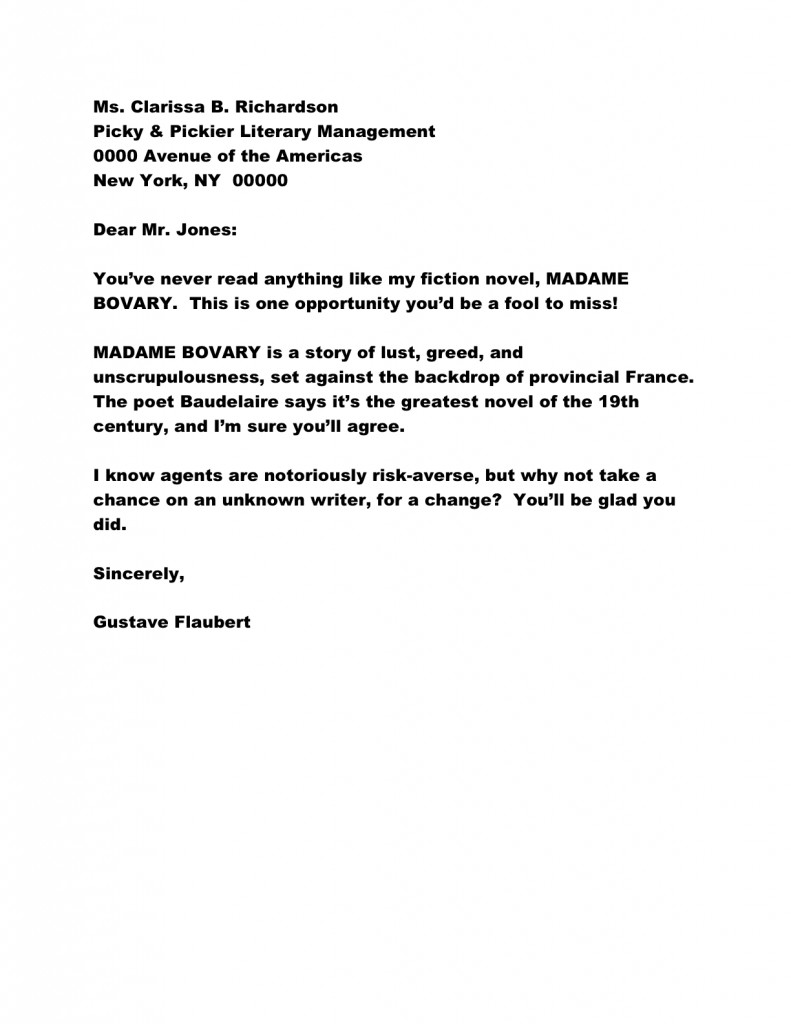
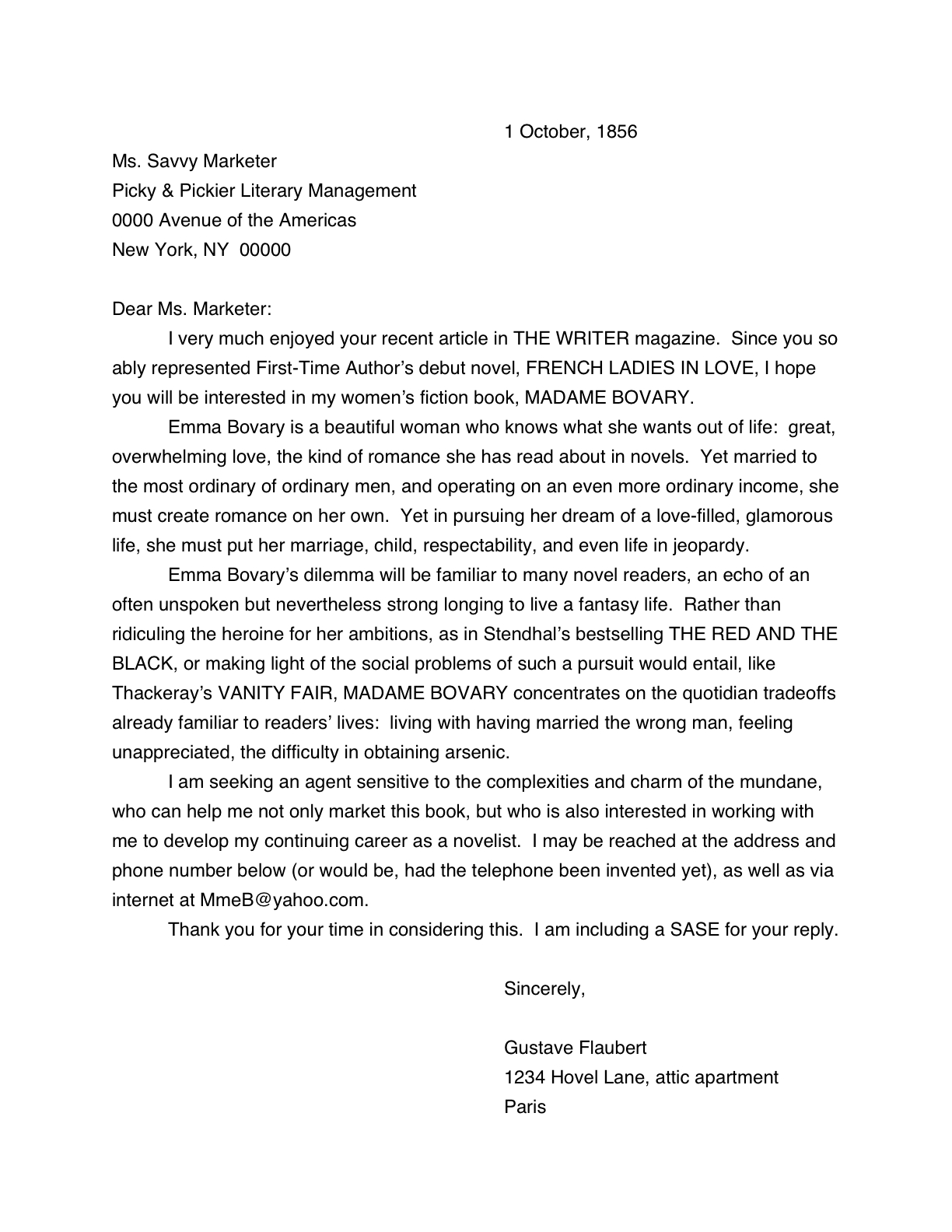


















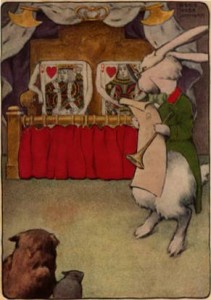














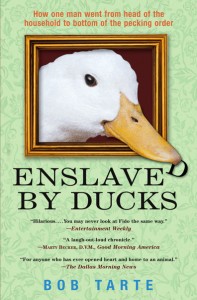 Enslaved By Ducks
Enslaved By Ducks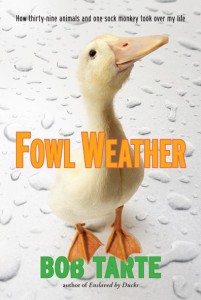 Fowl Weather
Fowl Weather









